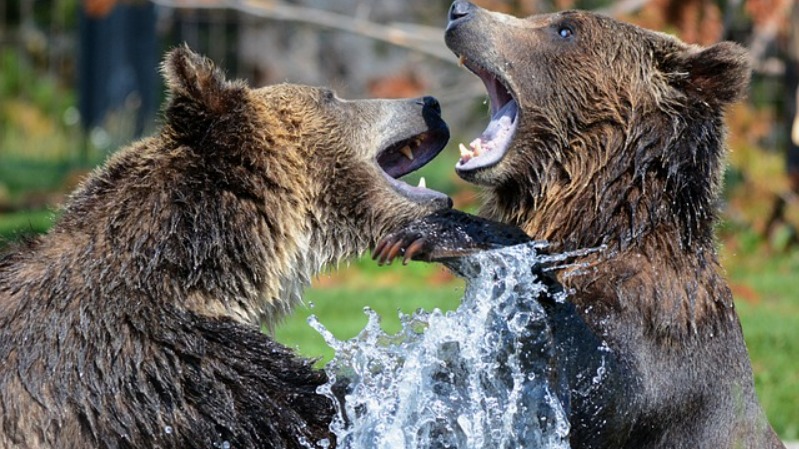Bear Safety: Grizzly Bear Territory
Some of North America’s most magnificent mountain ranges and national parks are prime grizzly bear habitat. That doesn’t mean be scared away. But learn to be bear aware and practice common-sense bear safety guidelines.
A great source of bear safety info is our National Park Service. It’s in their best interest for park visitors and bears to co-exist for the long-term safety of everyone involved—including the bears!
What’s the Real Danger from Bears?
Contents
It’s very rare anyone is killed by a bear in North America—on average, 3 each year. In fact, this Backpacker magazine article states almost 9 times as many people are killed by dogs in America each year than by bears. And 30 times as many are killed by lightning.
(Compare that to the 1.3 million in the US killed in traffic accidents, just to put it in perspective.)
Sorry so gloomy here, but my point is, we (I) tend to think life-threatening bear encounters are more common than they are.
BUT…that doesn’t mean we’re not aware and do what we can to minimize potential disastrous encounters. In fact, it’s probably due to the vigilance of the Park Service and the state DNRs that there are so few life-threatening encounters.
So, let’s get on with the safety tips…
National Park Service Video
First, take a look at this 8-minute video by the National Park Service for Glacier National Park:
(Video courtesy of the National Park Service in Glacier National Park, Montana. Special thanks to John Waller, bear biologist)
Practical Tips for Bear Safety
When you hike out in the backcountry in places like Yellowstone, the Tetons and Glacier, there will always be a slight chance you’ll encounter a bear. Here’s what to keep in mind:
- Don’t surprise bears at close range—make noise, clap, shout. If you do see a bear, keep your distance.
- Always carry bear spray when in grizzly country—and have it accessible! This is especially true if you plan to hike into the backcountry. Use a trusted brand like Frontiersman.
- Know the difference between black bears and grizzly bears. Your response will be different depending on the type of bear. A grizzly is more likely to be aggressive.
- Watch the above video for key pointers on what to do in particular situations, like: how to know the difference between a bluff charge and a full-out charge, and what to do in either case.
- Don’t let fear of a bear encounter keep you from enjoying the parks! Again, carrying bear spray, knowing how to use it, and keeping it accessible is the single best thing you can do. Here’s a page with a video about how to use bear spray.
When in your camp:
- Keep a spotless campsite. Absolutely no food scraps, dirty dishes, even water bottles laying around—especially if you leave camp. The rangers in the campgrounds in the big parks are extremely vigilant about this, resulting in very little trouble with bears in the campgrounds. You can do the same in the backcountry.
- If you meet a bear out on a hike or in your campsite, don’t throw your food at it as a deterrent to keep it away from you! It may work short-term, but you’ve just trained that bear to show aggression to a human for an easy lunch. That bear will become a nuisance and may eventually have to be destroyed.
Here’s another resource with some great tips from the National Park Service: Staying Safe around Bears.
Which Parks and Mountain Ranges are Grizzly Country?
Black bears can be found in most of Canada, many parts of the US and much of northern Mexico. They can be any color ranging between light brown to black.
Grizzly bear range covers the northern Rockies: All of western Canada and Alaska, and also the mountainous areas of Montana, Idaho, Wyoming and Washington. (I didn’t know this, but grizzlies are also found in most of northern Asia, Scandinavia and many parts of eastern Europe.)
If you’re traveling in Glacier, Yellowstone or the Tetons you’re in grizzly bear country. The Wind River range, southeast of the Tetons, is also grizzly territory.
If you want a mountain experience without worrying about meeting one of these giants, you have many great options (You’ll still likely be in black bear territory, though, so keep practicing bear safety):
- Bighorn Mountains in northcentral Wyoming
- Snowy Range Mountains in southeast Wyoming
- Pretty much all of Colorado, and other parts of the Rockies in the southern half of the US.
- The Black Hills in western South Dakota.
- The entire Appalachian Range in the eastern US.
Bears are amazing to see in the wild, especially grizzly bears. Know and practice bear safety guidelines and use common sense, and it’s very unlikely you’ll have any issues.

